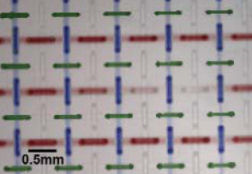A new way to build microscale pipes in three dimensions boosts the sophistication of chips that manipulate fluids to perform chemical reactions, biomedical tests, and other tasks, its developers say.

A drawback of most microfluidic chips is that their pipes often intersect because they’re all on one level. So valves must control fluid flows, notes Emil P. Kartalov of the University of Southern California in Los Angeles.
In one established method for making such single-layer chips, a chip builder coats a mold with a thick layer of liquid polymer called polydimethylsiloxane, or PDMS. Ridges in the mold form voids in the polymer that serve as channels for fluids once the material is peeled away and adhered to a glass backing.
In a new study that extends this method to multiple levels, Kartalov and his colleagues devised a simple means to make on-chip pipes that bend upward or downward so that fluids in different pipes can cross without mixing.
In the Aug. 15 Proceedings of the National Academy of Sciences, the researchers describe microplumbing made from molds with posts that poke through the liquid-polymer coating. This creates vertical channels through the resulting solid-polymer layer. Next, an additional solidified PDMS structure made on a different mold extends the vertical channels to a second level, where they feed into horizontal pipes again. Stacking up still more levels is possible, Kartalov adds.
The micropipes’ vertical jogs “do for microfluidics what overpasses and underpasses do for the highway system,” he says.





